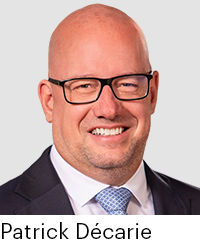
With extreme weather events on the rise, experts from the construction, insurance and claims management industries are looking at ways to build and rebuild differently.
During the Reconstruction: Changing the Way We Do Things panel discussion, held at the Property & Casualty Insurance Day conference organized by the Insurance Journal Publishing Group on April 2 at the Palais des congrès de Montréal, a number of concrete ways were explored to improve the capability of buildings to withstand hazards.
Rethinking materials
The starting point for the discussion was the basement. Marco Lasalle, Technical Director for the Association des professionnels de la construction et de l'habitation du Québec (APCHQ), points out that this typically North American architectural configuration may no longer be suited to today's climatic realities. But rather than banning them altogether, he suggests reviewing their design and layout.
“It's not normal to design a basement like a first floor,” he says. Using the same materials, such as medium-density fibreboard (MDF) baseboards or floating floors, leads to significant damage in the event of water infiltration.
According to Lasalle, it's time to adopt rot-proof materials that won't deteriorate in contact with water, both in basements and in the rest of the home.
In collaboration with Université Laval, the APCHQ has been working on the concept of the “perfect wall”, inspired by Dr. Joseph Lstiburek's perfect wall – a wall insulated entirely from the outside, which protects pipes from the cold and limits damage to the inside of the house.
A number of other ideas have been put forward: installing chimneys to access drains, providing a gravity drainage system with a bypass plan if the municipal network is overloaded, or using more resistant materials in high-risk areas.
A changing industry, but still too compartmentalized

With three decades' experience in claims settlement, Suzie Godmer, claims adjuster at Authentik, points to the difficulty of integrating resilient materials after a loss. “For a policyholder, a claim is never planned, either in their agenda or in their portfolio.”
These options are not always offered to customers, not least because players in the claims chain work in silos.
Better coordination between them is therefore essential. “Communication will be key, because if we want to move towards more resilient materials, we'll need underwriting insurers, claims adjusters, but also those in the field in post-disaster and reconstruction to be part of joint discussions,” she says.

Patrick Décarie, Regional Vice President, Property and Casualty Contact Centres, Co-operators, agrees. He points out that the increase in weather-related claims is forcing the industry to review its practices.
At The Co-operators, an initiative called TomorrowStrong allows policyholders to opt for more resilient repairs, such as installing a stronger roof after a hail event. “It's good for the customer, good for the environment and good for us,” he says.
This free rider pays for itself with the savings made by repairing rather than replacing, and by the fact that these more resilient repairs avoid future claims,” points out Décarie.
Repairing instead of replacing: a necessary shift
According to a survey conducted by Co-operators, 63% of Canadians prefer to repair rather than replace, but 23% are unaware that they can do so in the event of a claim. This lack of awareness leads to costly decisions, both financially and environmentally.
The insurance industry is also the source of a great deal of waste, as revealed by a study carried out by the insurer. But the challenge is real. Contractors specializing in resilience are rare, particularly in Quebec. “We need to develop the offering so that it becomes the norm,” says Décarie.
A crying need for education
All the panelists agree on one point: education is crucial for policyholders, contractors and brokers alike. Many people don't even know how their house is built,” says Suzie Godmer. “They don't know where the water comes in.”
She says that some policyholders are unaware of the existence of their backflow preventer, or don't maintain it. “Yet this is the first thing municipalities ask for when a claim is made,” she underlines. Better education would also help prevent repeat claims for the same causes, as observed during the 2017, 2019 and 2024 floods in Quebec.
A key role for brokers and agents
Brokers and agents also have a role to play in better guiding policyholders. “We've already been known to visit disaster-stricken homes worth around $700,000 or $800,000, which have $20,000 in coverage for a sewer backup in the basement,” says Godmer. “People are shocked. They expect it to be covered by their insurance. So, I think that before advising people on how much coverage they should get, we should find out what they have in their basement.”
For his part, Patrick Décarie stresses the importance of valuing the advisory role of insurance professionals. “They're not just order takers. They protect policyholders' assets, which is probably the most important thing for them,” he notes.
By visiting the premises at the time of a claim, insurance professionals could already be identifying other risks and communicating them to the customer to prevent future claims. “As a claims adjuster, you're already on the premises. Even if it's for an event other than water damage, why wouldn't we take the opportunity to observe how the basement is made to review the risks with the underwriter?” reflects Suzie Godmer.
We communicate the damage we see on the building, but we don't actually act to prevent a loss,” she continues. “But since we're already on site, I think it would be a good opportunity to do so.”
Towards certification for resilient homes?
The idea of a certificate for resilient homes was also raised. Such certification could help insurers to better assess risk and offer fairer premiums. “For automobiles, most insurers offer a discount when there's a theft prevention system. Perhaps in the home, we could have this kind of system for water detectors,” suggests Patrick Décarie, who sees a significant incentive potential.
In the same vein, Marco Lasalle mentions the Quebec government's work on construction quality. Bill 76 calls for at least three inspections of each building site, a measure welcomed by the APCHQ.
Shared responsibility
The message is clear: resilience must be a shared responsibility: citizens must educate themselves, entrepreneurs must adapt, insurers must support. And all must communicate with each other.
Everyone agrees that mentalities are changing, but slowly. Mandatory training for contractors is a step in the right direction, as are the joint efforts of APCHQ, Architecture Without Borders and other partners.
“A contractor who obtained his license in 1975 was not obliged to take any training, as long as he had his license. And yet, there are new building codes every five years. Today, it's 16 hours of continuing education every two years. It's not much, but you have to start somewhere,” says Marco Lasalle.







